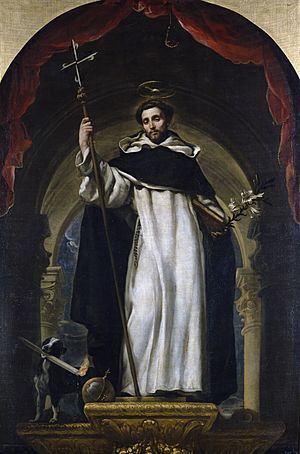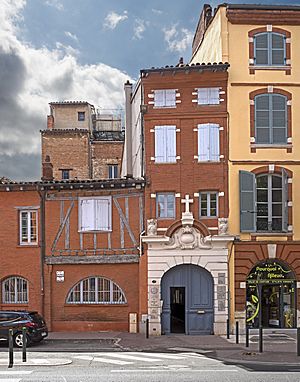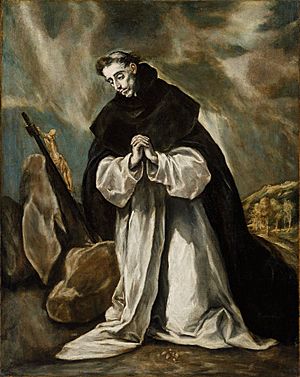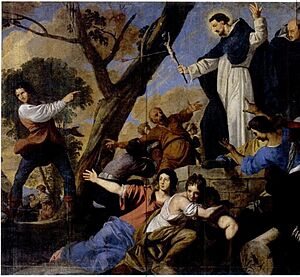Saint Dominic facts for kids
Quick facts for kids SaintDominic OP |
|
|---|---|

Santo Domingo de Guzmán, a painting by Claudio Coello in 1670
|
|
| Founder of the Order of Preachers Religious Priest |
|
| Born | 8 August 1170 Caleruega, Kingdom of Castile (today Castile-Leon, Spain) |
| Died | 6 August 1221 (aged 50) Bologna (today Emilia-Romagna, Italy) |
| Venerated in | |
| Canonized | 13 July 1234, Reiti Cathedral by Pope Gregory IX |
| Major shrine | Basilica of San Domenico |
| Feast |
|
| Attributes | Dominican habit, dog, star, lilies, book, staff, and a rosary |
| Patronage | Astronomers, Natural Sciences; Archdiocese of Fuzhou; astronomy; Dominican Republic; Santo Domingo Pueblo, Valletta, Birgu (Malta), Campana, Calabria, Managua |
Saint Dominic (born 8 August 1170 – died 6 August 1221) was a Castilian Catholic priest. He was also known as Dominic de Guzmán. He founded the Dominican Order, a group of religious people. Saint Dominic is the patron saint of astronomers and natural scientists. People sometimes called him Dominic of Osma or Dominic of Caleruega.
Contents
Life Story of Saint Dominic
His Birth and Early Years
Dominic was born in a town called Caleruega in Spain. This town is located between Osma and Aranda de Duero. He was named after another saint, Dominic of Silos.
An early story says that before Dominic was born, his mother had a dream. She dreamed that a dog with a flaming torch jumped out of her. This dog seemed to set the world on fire. This story became popular because his order was called the Dominican order. In Latin, Dominicanus sounds like Domini canis, which means "Dog of the Lord."
Dominic was raised by his parents, Juana and Felix. His mother, Joan of Aza, was later recognized as a blessed person by the Church.
His Education and First Jobs
When Dominic was 14, he went to study at a monastery and then at schools in Palencia. He spent six years studying the arts and four years studying theology.
In 1191, there was a terrible famine in Spain. Young Dominic gave away all his money and sold his clothes and books to help feed people. He famously said, "Would you have me study off these dead skins when men are dying of hunger?"
At 24, Dominic became a priest. He joined the group of priests at the Cathedral of Osma. In 1198, the bishop, Diego de Acebo, made Dominic a leader among these priests.
Starting the Dominican Order

In 1203 or 1204, Dominic traveled with Bishop Diego de Acebo on a special trip for the King of Castile. On their way back, they met monks who were trying to preach against the Cathars. The Cathars were a Christian group with different beliefs that the Catholic Church considered wrong.
Dominic and the bishop noticed that the monks were not very successful. They thought it was because the monks lived in luxury, while the Cathars lived very simply. So, Dominic and the bishop decided to live a simpler life. They began to preach in the south of France to try and convert the Cathars.
In 1215, Dominic gathered six followers and started a community in a house in Toulouse. He believed there was a need for a new type of religious group. This group would focus on education and preaching in the growing cities. They followed strict rules of prayer and penance.
Dominic went to Rome to get approval from the Pope. In December 1216 and January 1217, the new Pope, Honorius III, officially allowed Dominic to form the Ordo Praedicatorum, which means "Order of Preachers."
Later Years and Passing

A woman named Cecilia Cesarini, who joined Dominic's order, described him. She said he was "thin and of middle height." He had a "handsome and somewhat fair" face, "reddish hair and beard," and "beautiful eyes."
Dominic traveled a lot to stay in touch with his growing group of friars. However, his main base was in Rome. In 1219, Pope Honorius III invited Dominic and his companions to live at the ancient basilica of Santa Sabina. This became an important center for the Dominicans in Rome.
Dominic also spent time in Bologna, Italy. He helped establish a convent there and held the first two big meetings for his order in that city.
Dominic lived a very simple life. He avoided meat and often fasted. He chose the plainest clothes and never slept in a bed. When he traveled, he would teach and pray. He often walked barefoot and would praise God even when it rained or was uncomfortable.
Dominic died at the age of 51 in Bologna. He was very tired from all his hard work and simple living. He asked the monks to lay him on some sacking on the ground. He spent his last moments telling his followers to have love, stay humble, and value poverty. He passed away on 6 August 1221.
In 1234, Pope Gregory IX declared Dominic a saint. His remains were later moved to a special shrine in the Church of St. Dominic in Bologna.
Saint Dominic and the Rosary
The spread of the Rosary, a special prayer to Mary, is often linked to Saint Dominic's preaching. For many centuries, the Rosary has been very important to the Dominican Order. Pope Pius XI said that the Rosary is the main reason the Dominican Order exists.
Dominicans have played a big part in sharing the Rosary and teaching about its power. In Malta, people celebrate Saint Dominic's feast day with great joy. The Dominican order has strong ties with Malta.
Cord of Saint Dominic
The Cord of Saint Dominic is a Catholic item that reminds people of Saint Dominic's protection. People believe that if they wear this cord, they can receive special help from Saint Dominic. Some infertile couples use this cord to pray for children.
Places Named After Saint Dominic
Saint Dominic is one of the few historical figures who has two countries named after him: Dominica and the Dominican Republic. The capital city of the Dominican Republic, Santo Domingo, also carries his name.
When We Remember Saint Dominic
People remember Saint Dominic on different dates throughout the year, celebrating his life and important events related to him:
- 25 January – Remembering when his relics (remains) were moved.
- 24 May – Remembering the first time his relics were moved (in 1233).
- 5 June – Remembering the second time his relics were moved (in 1267).
- 13 July – Remembering the anniversary of him becoming a saint (in 1234).
- 8 August – This is the main day people celebrate Saint Dominic.
- 6 August – Remembering the day he died.
Images for kids
See also
 In Spanish: Domingo de Guzmán para niños
In Spanish: Domingo de Guzmán para niños
- Arca di San Domenico: The special shrine where Dominic's remains are kept.
- St. Dominic's Cathedral in Fuzhou: A church first built by Spanish Dominicans in 1864.
- Lives of the Brethren: A book written to record the lives of early Dominicans.
- Everton F.C., a famous football club, was originally named Saint Domingo's F.C.
- Saint Dominic in Soriano, a painting from 1530 believed to be miraculous.






